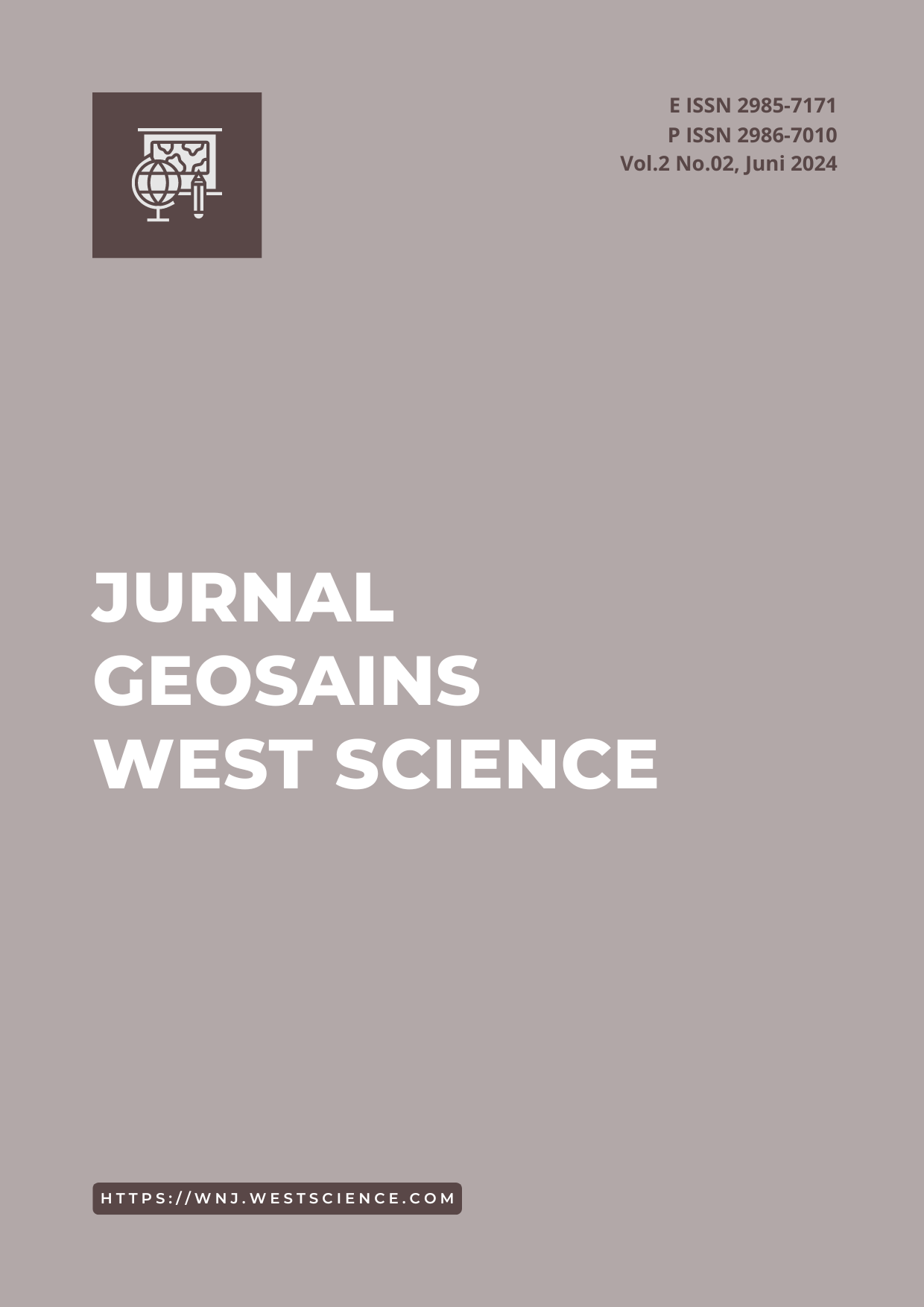Analisis Bibliometrik Terhadap Dinamika Penelitian di Bidang Geologi Ekonomi
DOI:
https://doi.org/10.58812/jgws.v2i02.1325Kata Kunci:
Geologi Ekonomi, Analisis Bibliometrik, VOSviewerAbstrak
Penelitian ini menggambarkan penggunaan VOSviewer untuk menganalisis klasterisasi tema, tren penelitian, kolaborasi antar penulis, dan potensi riset dalam geologi ekonomi. Hasil analisis memperlihatkan klasterisasi tema yang mengidentifikasi fokus penelitian utama seperti sistem hidrotermal, deposit porfiri, dan eksplorasi mineral spesifik. Analisis tren menunjukkan evolusi dalam penelitian dari konsep dasar ke teknik eksplorasi canggih. Penemuan kolaborasi antar penulis menggarisbawahi pentingnya jaringan kerja sama yang kuat dalam penyebaran pengetahuan. Selanjutnya, penelitian juga mengungkapkan area riset yang kurang dieksplorasi seperti rare earth elements dan Bushveld Complex, menawarkan peluang riset yang signifikan. Studi ini menekankan pentingnya analisis bibliometrik dalam menentukan arah masa depan penelitian geologi ekonomi, memberikan wawasan penting bagi peneliti dan praktisi dalam menyusun strategi pengembangan sumber daya bumi yang lebih efisien dan berkelanjutan.
Referensi
Ali, R. K., Qadaryati, N., & Kurniawan, R. W. (2021). Analisis Penilaian Situs Geologi Sebagai Peluang Pengembangan Geowisata di Kabupaten Bantul, Daerah Istimewa Yogyakarta. Jurnal Ilmiah Pariwisata, 26(1), 70–85.
Bodyuk, A. (2022). Subsantion of economic resource geology. Problems of Innovation and Investment Development. https://doi.org/10.33813/2224-1213.28.2022.19
Brown, M. (2014). The contribution of metamorphic petrology to understanding lithosphere evolution and geodynamics. Geoscience Frontiers, 5(4), 553–569.
Cheng, M., Adekola, O. A., Shah, M., & Valyrakis, M. (2018). Exploring Chinese students’ experience of curriculum internationalisation: a comparative study of Scotland and Australia. Studies in Higher Education, 43(4), 754–768.
Cooke, D. R., Hollings, P., & Walshe, J. L. (2005). Giant porphyry deposits: characteristics, distribution, and tectonic controls. Economic Geology, 100(5), 801–818.
Doggett, M. (2022). Mineral economics and the business of mineral supply. SEG Newsletter, 131, 25–39.
Feinman, G. (2008). Economic Archaeology. In Encyclopedia of Archaeology (pp. 1114–1120). https://doi.org/10.1016/B978-012373962-9.00094-7
Grant, J. A. (1986). The isocon diagram; a simple solution to Gresens’ equation for metasomatic alteration. Economic Geology, 81(8), 1976–1982.
Groves, D. I., Goldfarb, R. J., Robert, F., & Hart, C. J. R. (2003). Gold deposits in metamorphic belts: overview of current understanding, outstanding problems, future research, and exploration significance. Economic Geology, 98(1), 1–29.
Gustafson, L. B., & Hunt, J. P. (1975). The porphyry copper deposit at El Salvador, Chile. Economic Geology, 70(5), 857–912.
Hedenquist, J. W., Arribas, A., & Reynolds, T. J. (1998). Evolution of an intrusion-centered hydrothermal system; Far Southeast-Lepanto porphyry and epithermal Cu-Au deposits, Philippines. Economic Geology, 93(4), 373–404.
Hoal, K. E. O., & Frenzel, M. (2022). Ores drive operations—Economic geology is the foundation of geometallurgy. SEG Newsletter, 129, 30–43.
Huston, D., & Gutzmer, J. (2023). Isotopes in Economic Geology, Metallogenesis and Exploration. Springer Nature.
James, H. L. (1954). Sedimentary facies of iron-formation. Economic Geology, 49(3), 235–293.
Jia, R., & Dai, L. (2021). Analysis of economic benefits of mineral resources development ecological environment based on ecological footprint. Arabian Journal of Geosciences, 14, 1–19.
Matheron, G. (1963). Principles of geostatistics. Economic Geology, 58(8), 1246–1266.
Moghadam, A. R., Lotfi, M., Jafari, M. R., Ardalan, A. A., Moghaddam, M. P., & Yazdi, A. (2021). Economic Geology, Petrology and Environmental of Copper Ore Deposits of Chagho in South West Karaj. Revista Geoaraguaia, 11(1), 7–26.
Ohmoto, H. (1972). Systematics of sulfur and carbon isotopes in hydrothermal ore deposits. Economic Geology, 67(5), 551–578.
Richards, J. P. (2003). Tectono-magmatic precursors for porphyry Cu-(Mo-Au) deposit formation. Economic Geology, 98(8), 1515–1533.
Ruban, D. A., Ermolaev, V. A., & van Loon, A. J. (2022). Better Understanding of Geoheritage Challenges within the Scope of Economic Geology: Toward a New Research Agenda. Heritage, 6(1), 365–373.
Sillitoe, R. H. (2010). Porphyry copper systems. Economic Geology, 105(1), 3–41.
Simandl, L., Simandl, G. J., & Paradis, S. (2021). Economic Geology Models 5. Specialty, critical, battery, magnet and photovoltaic materials: Market facts, projections and implications for exploration and development. Geoscience Canada, 48(2), 73–92.
Skinner, W. (2020). Wine, geology mapping and the value of place in McLaren Vale. The Australian Journal of Anthropology, 31(1), 85–100.
Varley, P. R., Buchanan, D., Bilderback, A., Wisniewski, M. K., Johanning, J., Nelson, J. B., Johnson, J. T., Minnier, T., & Hall, D. E. (2023). Association of routine preoperative frailty assessment with 1-year postoperative mortality. JAMA Surgery, 158(5), 475–483.
Vinkler, P. (2010). Indicators are the essence of scientometrics and bibliometrics: Comments to the book entitled “Bibliometrics and Citation Analysis, From the Science Citation Index to Cybermetrics” from Nicola De Bellis. Scientometrics, 85(3), 861–866.
Wang, X., Xu, Z., & Škare, M. (2020). A bibliometric analysis of Economic Research-Ekonomska Istra zivanja (2007–2019). Economic Research-Ekonomska Istraživanja, 33(1), 865–886.
Unduhan
Diterbitkan
Cara Mengutip
Terbitan
Bagian
Lisensi
Hak Cipta (c) 2024 Yana Priyana

Artikel ini berlisensiCreative Commons Attribution-ShareAlike 4.0 International License.



















 Instagram
Instagram 